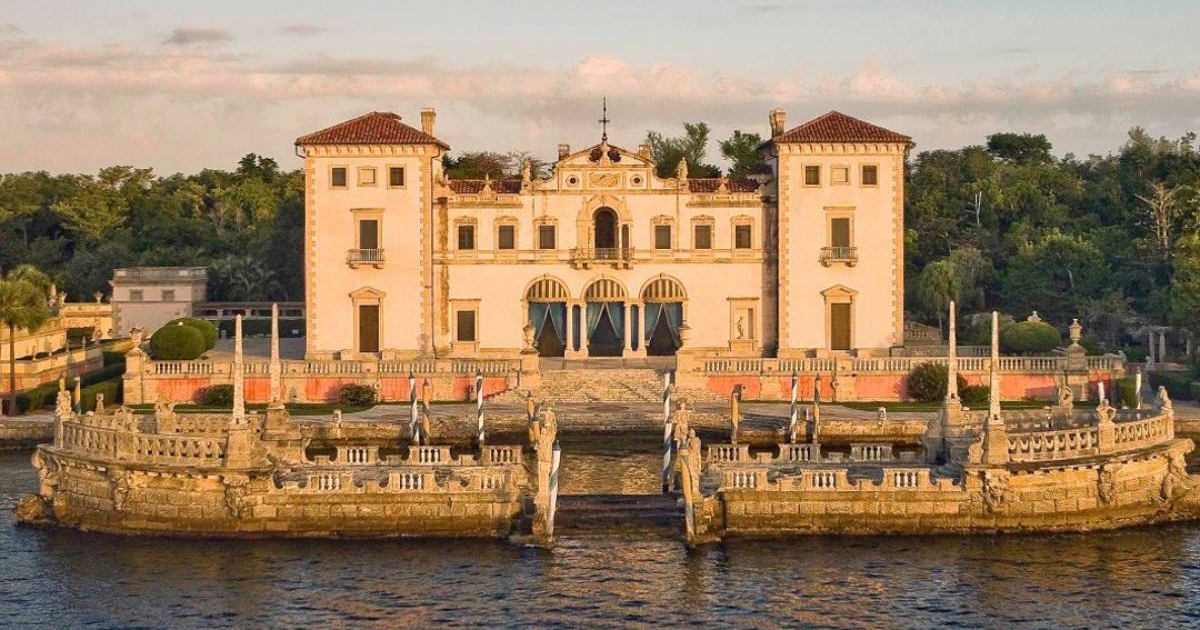
The neighborhood ofCoconut Grove, in Miami, houses a mansion from the beginning of the 20th century, with gardens inspired by the Italian Renaissance. In its origins it was known as theVilla Vizcaya and today it is a distinguished cultural institution, theVizcaya Museum and Gardens.
TheVilla Vizcaya has its origins in the first decade of the 20th century, when the American businessmanJames Deering (1859 – 1925) built his winter residence on the shores of Biscayne Bay.
At this time it was not easy to obtain building materials in Florida. Villa Vizcaya was built withlimestone rocks brought from Cuba. Deering put so much care into every detail of this mansion that the building and its gardens became, half a century later, a monumental complex of heritage value.
History of Villa Vizcaya
The original property was a 180-acre tract of coastal mangroves and tropical forest. Everything was transformed by the integrative gaze of three men who strived to fulfill the millionaire's aesthetic whims. The first of them was the designerPaul Chalfin.
Chalfin met Deering in 1910 and they had a long friendship. He accompanied him on his travels through Europe, acquiring furniture, works of art and objects of great value that are currently part of the museum's collection.
It was he who asked the American architectFrancis Burrall Hoffman, the design of the façade of the main house, influenced by the Italian Renaissance and Mediterranean styles. Burral began the project of theVilla Vizcayain 1912 and abandoned it in 1917, a year after finishing the mansion.
The third important figure was the Colombian landscape architectDiego Suarez, in charge of integrating the extensive gardens with the natural landscape of forests and the unique community that grew up nearby.
Deering began living inVilla Vizcaya in 1916, although the construction and gardens were completed around 1923. The works had atotal cost of 15 million dollars and nearly 1,000 workers worked in them.
James Deering and his exotic pleasures
Historians say that Deering had a triumphal entry into his mansion. He arrived at his beautiful home on Christmas night, 1916, sailing on theNepenthe, his luxury yacht. Since then every year he went to Florida to spend the winters.
The mansion was decorated withGreco-Roman sculptures, refined furniture and an excellent collection of works of art.
Despite so many riches and luxuries, Deering was a very reserved man. The little that is known about his intimate life is kept by the museum's Archive, in its collection of letters, telegrams and personal documents.
The millionaire philanthropist and conservationist was proud of the project he had achieved. However, he was not able to enjoy his mansion for long. Died on the steamboatSS City of Paris, in September 1925, when he returned from a trip from Europe to the United States.
The Vizcaya mansion and the inexorable passage of time
The mansion was inherited by Deering's two nieces,Marion Deering McCormick andBarbara Deering Danielson, who failed to maintain it. The house, its gardens and grounds, required constant expenses for itsproximity to the sea.
In addition, the hurricanes affected the mansion and as time went by they had to make large investments to save the property. In the 1940s they decided to sell a large part of the land to the Catholic Archdiocese.
Finally, in 1952, the house and gardens were acquired by theMiami-Dade County, for only 1 million dollars. They later developed important restoration projects on the property and it began to function as a museum. In 1994 it becameNational Historical Monument.
Vizcaya Museum and Gardens
The entire area occupies about 50 acres. The main house is 45,225 square feet. In total there are 54 rooms, of which 34 have been decorated and are open to the public. There is also a service area in the basement, which was originally intended to house the electrical infrastructure, warehouses and rooms for staff.
Currently some of these functions are maintained and offices were created for museum workers. In addition, in this area there are archives, art collections and restoration workshops.
The rooms open to the public have a mix of styles. Visitors must be very careful with everything they touch. All the elements in the house are loaded withhistorical and cultural value.
The property has hosted important events such as the meeting between President Ronald Reagan and Pope John Paul II during his first visit to Miami, or the firstSummit of the Americas.
The museum organizes outdoor events, free yoga classes, local agricultural product fairs, art exhibitions, concerts and many more activities. It is relatively close to downtown Miami.
The non-profit organizationVizcaya Museum and Gardens Trust manages the main building and its surrounding areas, although this complex is property of Miami-Dade County.
What do you think?
COMMENTFiled in: